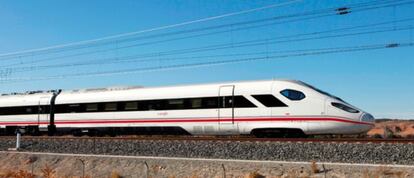High-speed miracle questioned
The train disaster in Santiago has dealt a hard blow to the local railway industry Spain’s participation in several international projects is now up in the air

Spain is a world leader in high-speed trains. The country’s AVE network of 3,100 kilometers is second only to China’s, a country with a population of 1.3 billion people, 27 times more than Spain’s, and with a surface area 20 times bigger. In terms of kilometers of high-speed track per inhabitant, no country in the world comes close to Spain.
Spain’s high-speed love affair began in 1992, when the line between Madrid and Seville was opened, marking a year commemorating the 500th anniversary of Christopher Columbus’ arrival in the Americas, Barcelona hosting the Olympics, the Expo in Seville, and Madrid as European Capital of Culture.
Since then, the high-speed train industry has grown, and is now worth around five billion euros a year, exporting 60 percent of output. Last year, despite the depression, Spain’s railway industry recorded the second-highest growth in output in the country.
The AVE has become one of the country’s best-known products, an ambassador for Brand Spain. The recent success of the so-called “pilgrim AVE,” the route between Medina and Mecca in Saudi Arabia, the biggest contract awarded to a Spanish consortium at 6.7 billion euros, has helped reinforce Spain’s image as a country with major export potential.
The Spanish railway industry has annual revenues of 4.8 billion euros
Government and the private sector have worked together to create this Made in Spain product, with an eye on high-speed projects in Brazil, the United States, Turkey and Kazakhstan. But last week’s accident in Galicia could damage the country’s chances of claiming a share of the global market, even though neither the line nor the train itself were high speed. The horrific train crash that killed 79 people comes at the worst time for the recession-hit nation’s railway sector, which is pushing to win new markets for its high-speed trains.
The train derailed about four kilometers from the station in the northwestern city of Santiago de Compostela last Wednesday. A dramatic 10-second video from a railway security camera, seen around the world, shows the train rocketing around a curve, slamming into a concrete wall at the side of the track as the engine overturns.
EL PAÍS reported that one of the two drivers on board said he was doing 190 kilometers per hour as he took the bend, where the speed limit is just 80 km/h.
The investigation is trying to find out why the train was going so fast and why security devices to keep speed within permitted limits did not slow the train.
The high-speed train network has involved investments of 45 billion euros
Spain’s railway industry has yet to comment on the accident, and not even the companies directly involved have offered any explanation. Talgo, the maker of the train involved in the accident, along with the consortium of companies (Thales, Dimetronic-Siemens, Cobra, and Antalis) that installed the security and signaling system on the Ourense-Santiago line have also decided to keep quiet for the moment, saying they prefer to await the outcome of the ongoing investigation.
The danger is that the longer the investigation becomes, the more risk there is that Spain will lose international contracts. The route between São Paulo and Rio de Janeiro is worth 12 billion euros and could be at risk if, as a result of the investigation, it appears that Spain’s high-speed rail network is not safe. These concerns have prompted the head of the regional government of Galicia, Alberto Núñez Feijóo, to hint darkly at “economic interests” in other countries criticizing the safety of Spain’s network to favor their own bids for high-speed rail lines.
Spain’s high-speed railways are not just important economically. There are political implications as well. Both of the country’s main parties, the Popular Party (PP) and the Socialist Party (PSOE), see the AVE as an important electoral weapon, prioritizing it over education and health. Former prime ministers José María Aznar and José Luis Rodríguez Zapatero of the PP and PSOE respectively, both highlighted the importance of joining up the country’s towns and cities via fast trains. The government’s PITVI 10-year infrastructure plan, drawn up amid an unprecedented economic depression, sets aside 25 billion euros for the AVE, six billion euros more than for roads.
Below is an overview of Spain’s high-speed rail industry:
A powerful, Made in Spain industry. Spanish railway equipment and material manufacturers produced some 4.8 billion-euros of goods in 2012, of which 2.8 billion were exported, a 21 percent increase on the previous year. After organic chemical products, the sector grew faster than any other in terms of overseas sales. Unlike other sectors that have relocated to other countries with lower labor costs, Spain’s railway industry has stayed in Spain, employing around 18,000 people.
The Talgo, Siemens, CAF, and Alstom plants that produce AVE material are among the most important to the rail industry. Aside from making trains, Thales, Dimetronic-Siemens, Alstom and Indra also produce signaling equipment, while FCC, Acciona, Ferrovial, ACS, OHL, and Comsa, among others, provide infrastructure and logistics. But the biggest players are public companies: Renfe, the state railway operator, and its infrastructure and management affiliate, Adif.
International megaprojects worth billions of euros. The biggest megaproject and the one closest to being adjudicated (before the end of this year) is the high-speed corridor between Brazil’s two biggest cities, São Paulo and Río de Janeiro. The contract could be worth as much as 12 billion euros, but requires bidding companies not to have had a fatal accident in the last five years.
Kazakhstan is also planning to build a high-speed rail link across the steppes of Eurasia between Almaty and its new capital of Astana. Spain already has a foothold in the country, where it has sold Talgo trains, while diplomatic relations are at an all-time high.
King Juan Carlos has been working hard to help secure the contract for a route that would make it possible to travel between Moscow and St Petersburg in two-and-a-half hours, and worth an estimated 14 billion euros.
Spanish companies are also keeping an eye on developments in California, where a 1,330-kilometer, 60-billion-euro route is planned between the state capital of Sacramento and San Diego, close to the Mexican border.
A huge network for a small country. Spain is the country of the AVE, a trade name that Renfe has succeeded in promoting as the generic name for all high-speed rail lines. Spain has a total of 3,100 kilometers in service, along with 11,000 kilometers of conventional track. There are 31 stations in 21 provinces, reaching 60 percent of the population. Adif is building 1,500 kilometers of new track, with a further 900 planned. The priority is now to connect Galicia, and to a lesser extent, the Basque Country.
An affordable luxury? The AVE is fast, but expensive. Ever since the government of Felipe González decided to build a high-speed line between Madrid and Seville, the AVE network has soaked up more than 45.120 million euros. Each kilometer of AVE track costs more than 10 million euros: 13.3 million euros in the case of the Madrid-Barcelona stretch; or 11 million euros between the capital and Alicante. This investment is paid for by the taxpayer, and as the cost will never be recovered through ticket sales, is to all intents and purposes a subsidized loss-making service.
Even countries like France, which pioneered European high-speed rail travel, have decided not to invest further. French President François Hollande, after reading the so-called Duron report, has opted for conventional lines linking regional and commuter routes over high-speed infrastructure projects, saying the latter are “scarcely profitable.” The Portuguese government has now finally decided it will not be building its side of the proposed high-speed link between Madrid and Lisbon. The government of Prime Minister Mariano Rajoy, continuing the policies implemented by his predecessor Zapatero, plans to close down what are deemed unprofitable long and medium-distance routes (as though the AVE were in some way a more economical alternative).
We like fast trains, but commuter routes are more popular. Around a total of 150 million passengers have taken the AVE since the inauguration of the Madrid-Seville route on April 21, 1992. Last year, 22.35 million people travelled by high-speed rail, a drop of 2.1 percent on the previous year due to the crisis, prompting the government to reduce ticket prices. This is a huge investment when seen in light of the numbers of people who use commuter services: of the 463 million train journeys in 2012, 88 percent were on local commuter lines.
Safety under suspicion. Last week’s tragedy in Galicia has put the focus on rail safety systems: the ASFA (Automatic Signaling and Break Warning), and the ERTMS (European Rail Traffic Management System). The first works on conventional lines and on some AVE stretches of track and stations. It does not stop the train unless it passes a red light or reaches 200 km/h.
The ERTMS monitors not just a train’s speed, but also the conditions of the track, the train, and other traffic, and in the case of problems such as excessive speed, triggers an automatic driving system that will slow the train down. This is not necessarily used exclusively on high-speed routes. The line between Madrid and Alicante, launched on June 17, will not feature ERTMS until January. Despite this, Spain has more kilometers of ERTMS-protected track (1,786 kilometers), more than half of the total high-speed network.
The Formula 1 of railways. Spain’s AVE trains run at an average speed of 222 km/h, faster than Japan’s bullet trains (218 km/h) and France’s 215 km/h. To do this they must at times be capable of running at more than 300 km/h. Spanish train-makers have developed some very advanced models. Siemens has its S-103; Talgo its 350 and its latest, Avril; CAF has launched the Oaris, while Alstom has remodeled its 100 series, which covers the Madrid-Seville route. Each costs more than 25 million euros.
Tu suscripción se está usando en otro dispositivo
¿Quieres añadir otro usuario a tu suscripción?
Si continúas leyendo en este dispositivo, no se podrá leer en el otro.
FlechaTu suscripción se está usando en otro dispositivo y solo puedes acceder a EL PAÍS desde un dispositivo a la vez.
Si quieres compartir tu cuenta, cambia tu suscripción a la modalidad Premium, así podrás añadir otro usuario. Cada uno accederá con su propia cuenta de email, lo que os permitirá personalizar vuestra experiencia en EL PAÍS.
¿Tienes una suscripción de empresa? Accede aquí para contratar más cuentas.
En el caso de no saber quién está usando tu cuenta, te recomendamos cambiar tu contraseña aquí.
Si decides continuar compartiendo tu cuenta, este mensaje se mostrará en tu dispositivo y en el de la otra persona que está usando tu cuenta de forma indefinida, afectando a tu experiencia de lectura. Puedes consultar aquí los términos y condiciones de la suscripción digital.
More information
Últimas noticias
From digital curfews to blocking apps: How technology experts protect their children online
Why the price of coffee has skyrocketed: from Brazilian plantations to specialty coffee houses
Confined to a Cuban hospital: When electricity is a matter of life or death
The complicated life of Francesca Albanese: A rising figure in Italy but barred from every bank by Trump’s sanctions
Most viewed
- Why we lost the habit of sleeping in two segments and how that changed our sense of time
- Trump’s obsession with putting his name on everything is unprecedented in the United States
- Pablo Escobar’s hippos: A serious environmental problem, 40 years on
- The Florida Keys tourist paradise is besieged by immigration agents: ‘We’ve never seen anything like this’
- Charles Dubouloz, mountaineering star, retires at 36 with a farewell tour inspired by Walter Bonatti










































